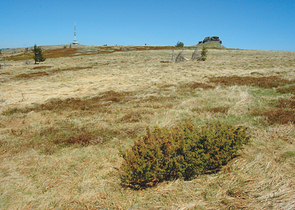The Journal is published by the Nature Conservation Agency of the Czech Republic in cooperation with the Cave Administration of the Czech Republic, the Krkonoše Mts. National Park Administration, the Bohemian Forest Mts. National Park Administration, the Podyjí National Park Administration and the The Bohemian Switzerland National Park Administration. It has been published since 1946.
cs / en
Nature Conservation 4/2010 — 14. 9. 2010 — Research, Surveys and Data Management — Print article in pdf
Actual situation of alpine juniper (Juniperus communis subsp. alpina (Smith) Čelakovský) and its per
současný stav a perspektivy v Hrubém Jeseníku

Alpine juniper (Juniperus communissubsp. alpina) is an amphiboreal arctic-alpine taxon that is vicarious for common juniper above the alpine timberline and in the Artic.
It is considered one of early colonizers of the post-glacial landscape and its present populations in Central Europe are only fragments of its distribution at that time. The Hrubý Jeseník Mts., the oreophyticum of High Sudeten, is considered to be an area with the most numerous occurrence of alpine juniper in the east part of the Czech Republic. Alpine juniper occurs in the Hrubý Jeseník Mts. above the line that is determined approximately by the alpine timberline. The present total number of junipers in the area definitely does not exceed 300 individuals, which are concentrated into 13 localities. However 20 localities was mentioned by botanists during 20th century. Alpine juniper in the Hrubý Jeseník Mts. has been in recession, both as for the number of localities where it occurs, and in terms of abundance in most sites. It is obvious the decrease of the numbers of alpine juniper in the Hrubý Jeseník Mts. and the changes in the shrubs health status within the single populations are caused by a complex of several factors. Populations are virtually influenced by the global changes and type of land management, both in the past and at present. Little is known how climate change affects nitrogen deposition, species distributions in communities and relations among plants in that area. Much more, juniper colonizes its biotope usually as a result of intensive pasture, that is followed by erosion, land movement and subsequent decrease of disturbance intensity. Hence, the contemporary state of juniper shrubs is probably based on pasture documented in the Hrubý Jeseník Mts. until the middle of 20th century and following slow shifts of environmental factors. The influence of game was recorded and the presence of Oligotrophus juniperinusand Otiorrhynchus nigerwas proved as insect pests of alpine juniper in the Hrubý Jeseník Mts. Juniper shrubs is also affected by vicinity of higher shadowing woody species in the alpine environment, namely the dwarf pine (Pinus mugo) planting. Unfortunately, there was not confirmed fertility for all individuals from Hrubý Jeseník Mts. and none of the study from this area quantified the amount of fruits and fruit-giving individuals of alpine juniper in more detail. The Hrubý Jeseník Mts. populations of alpine juniper probably persisted in a form of long-life individuals that occasionally reproduce in a vegetative way. Management proposals consist ingenetic structure test of populations, the profound study of breeding system and dispersal problems, the intentional disturbance of the vegetation and the reduction of shading woody species.

